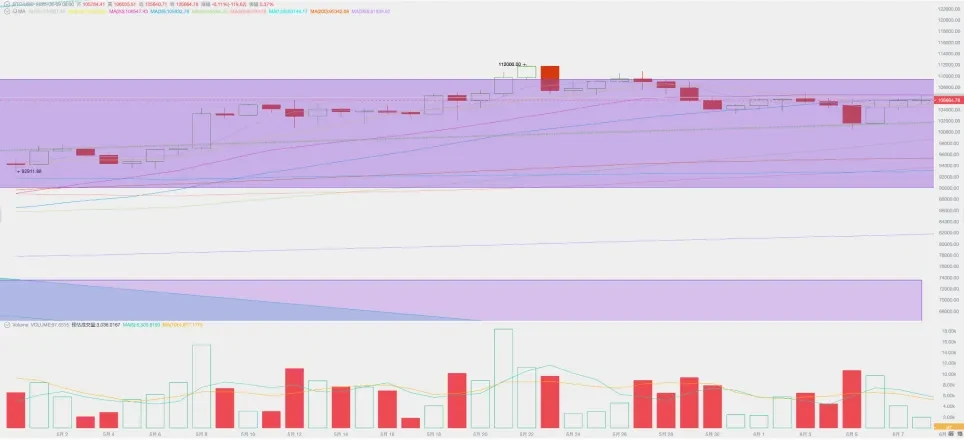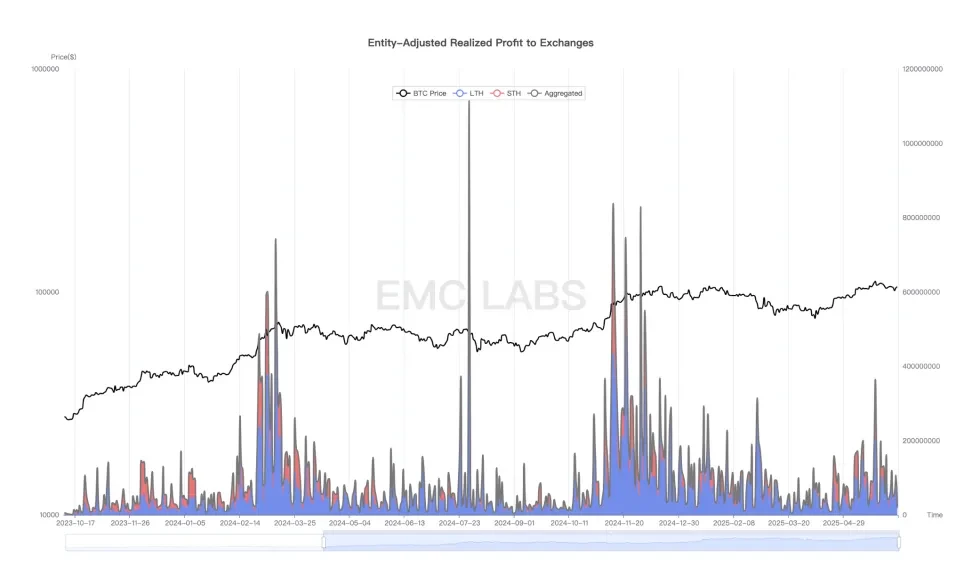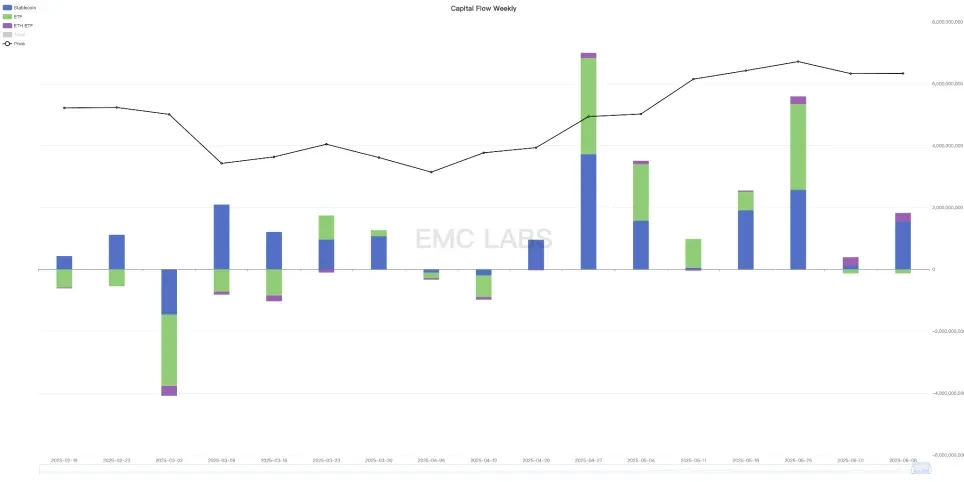The information, opinions, and judgments regarding the market, projects, cryptocurrencies, etc., mentioned in this report are for reference only and do not constitute any investment advice.

Since the low in April, BTC has rebounded by as much as 50%, outperforming the Nasdaq and setting a new historical high.
However, the significant short-term increase has also accumulated some selling pressure. Since May 22, a large-scale sell-off has begun in the BTC market. This has created some pressure on BTC, which is at a high level and leading the U.S. stock market, becoming a driving force for the decline in BTC prices.
With no upward momentum, BTC dipped this Thursday amid market panic stemming from the conflict between Trump and Musk, testing the $100,000 support level. The price then rebounded continuously, returning above the "first upward trend line."
Accompanied by adjustments in the U.S. stock market, the buying power in the BTC Spot ETF channel has contracted, making it difficult for BTC to absorb selling pressure and continue rising in the short term. However, it is worth noting that the outflow from exchanges has significantly increased alongside the price correction this week, indicating that new funds are taking the opportunity to accumulate chips.
The positive news from non-farm employment data has created a favorable atmosphere for BTC's stabilization and rebound, but a true breakthrough to new levels may still require greater progress in the "reciprocal tariff war," "cryptocurrency policy," or Federal Reserve interest rate cuts.
Policy, Macroeconomic Finance, and Economic Data
This week, the U.S. released non-farm employment data, showing an increase of 139,000 jobs in May, which, although a new low since February, was slightly above the market expectation of 126,000. The U.S. unemployment rate in May was 4.2%, in line with expectations and unchanged from the previous value of 4.2%, indicating no deterioration.
The data slightly exceeded expectations, driving the three major U.S. stock indices up and gold down.
In recent reports, we emphasized that U.S. stock trading revolves around two main lines:
Pricing the U.S. economy as a "soft landing," "hard landing," or entering a recession based on hard economic and employment data. Currently, the market pricing is close to a "soft landing," meaning that after experiencing rapid growth and high inflation over the past few years, the economy is gradually slowing to a sustainable growth level without experiencing severe economic recession or mass unemployment. The current economic and employment data aligns with this characteristic, although GDP growth has shown some decline, it is due to the Federal Reserve's proactive cooling measures, inflation data is declining in an orderly manner, the unemployment rate is stable, and new job numbers have not significantly decreased. Of course, this also means that the Federal Reserve's interest rate cuts will inevitably be delayed.
Anticipating potential changes in the medium to long-term economy and market caused by "reciprocal tariffs" and other government policies, and pricing them through forward-looking trading. The market crash in early March to early April was a forward pricing reaction to the unexpected "reciprocal tariffs" and the potential inflation and employment deterioration they could cause, while the market rebound after April 7 was a forward pricing reaction to Trump's "softening" attitude and the economic "soft landing." This forward pricing includes the expectation that the "reciprocal tariff war" will end relatively mildly, will not lead to worsening inflation in the U.S., will not significantly impact corporate profits, and that there will be two 50 basis point interest rate cuts in the second half of this year.
In the May Monthly Report, we pointed out that the current market pricing is overly optimistic, and further upward pricing in the short term is too optimistic. In fact, there are still many uncertainties regarding the reciprocal tariff war.
In the past week, U.S. and Chinese leaders had their first call since the tariff war began. Although the subsequent statement emphasized respect and reciprocity, and agreed that representatives from both sides would soon negotiate in the UK, it is clear that they are still in the negotiation stage, and it will take time before a deal is signed.
Additionally, this week, significant events affecting the market included Musk's public attacks on the "Beautiful Big Bill" and Trump. Musk called the bill "disgusting" and urged the public to pressure Congress to block its passage, while Trump threatened to cancel federal contracts with Musk's companies. This dispute led to Tesla experiencing its largest single-day drop ever on Thursday, also triggering significant declines in U.S. stock indices and BTC. However, this conflict is currently an isolated incident and is unlikely to have a long-term impact on market trends.
Overall, driven by slightly better-than-expected non-farm data and the slowly advancing "reciprocal tariff" negotiations, U.S. stocks, U.S. bonds, and the dollar maintained a fragile balance and tilted slightly towards optimism over the past week.
Cryptocurrency Market
In the rebound since April, BTC's performance has led the Nasdaq. The U.S. stock market is gearing up to challenge previous highs, while BTC set a new historical high on May 22.
From a technical perspective, after reaching a new high in the rebound, BTC has undergone a two-week correction, retreating 3.07% last week and slightly rising 0.08% this week, showing a long-legged doji on the weekly chart. During this adjustment process, trading volume has been shrinking.
The maximum correction over the past two weeks was around 10%, overall occurring within the "Trump bottom," with the lowest day testing the "first upward trend line" this Thursday.
Given that the U.S. stock market has not yet challenged new highs, this adjustment after BTC set a new high is foreseeable and healthy. A period of consolidation is likely inevitable, and for the market to reach new highs and ascend further, greater progress in the "reciprocal tariff war," "cryptocurrency policy," or Federal Reserve interest rate cuts may be required.
Selling Pressure and Sell-offs
Since April, following a rebound from the depths of despair, BTC has recorded a maximum increase of 50%.
With the new historical high, both short-term bottom-fishing funds and jittery long-term funds have experienced some selling. This selling pressure peaked on May 22 and has since gradually decreased.

On-chain realized profits have been on a downward trend since May 22.
It is important to note that as selling decreases, the outflow from centralized exchanges has increased, reaching 76,520.72 BTC this week, which is significantly higher than the usual weekly outflow of 10,000 to 20,000 BTC. This substantial outflow can be seen as a strong recognition of the current price by long-term funds.
Capital Inflows and Outflows
After a phase of floating profits, even profit realization has occurred in the ETF channel funds.
In the past two weeks, the BTC Spot ETF channel has seen a slight outflow of funds, with $135 million last week and $128 million this week. This outflow occurred during a significant rise in BTC and amid fluctuations in the U.S. stock market.

Statistics on inflows and outflows of stablecoins and ETF channel funds (weekly)
Isolated, it is difficult to predict when this channel's funds will return to inflow, but considering the overall trend of the U.S. stock market, we believe there is little need for concern about a significant downturn. Although there is a technical possibility of continuing to test the $100,000 level, it is challenging to grasp, and in a fragile balance of supply and demand, a breakthrough rise could occur within a day or two.
Cycle Indicators
According to eMerge Engine, the EMC BTC Cycle Metrics indicator is at 0.625, indicating an upward phase.
EMC Labs
EMC Labs was established in April 2023 by cryptocurrency asset investors and data scientists. It focuses on blockchain industry research and investments in the crypto secondary market, with industry foresight, insights, and data mining as its core competitive advantages. It aims to participate in the thriving blockchain industry through research and investment, promoting the benefits of blockchain and cryptocurrency assets for humanity.
For more information, please visit: https://www.emc.fund
免责声明:本文章仅代表作者个人观点,不代表本平台的立场和观点。本文章仅供信息分享,不构成对任何人的任何投资建议。用户与作者之间的任何争议,与本平台无关。如网页中刊载的文章或图片涉及侵权,请提供相关的权利证明和身份证明发送邮件到support@aicoin.com,本平台相关工作人员将会进行核查。




